Asia Pacific Syngas Market Size
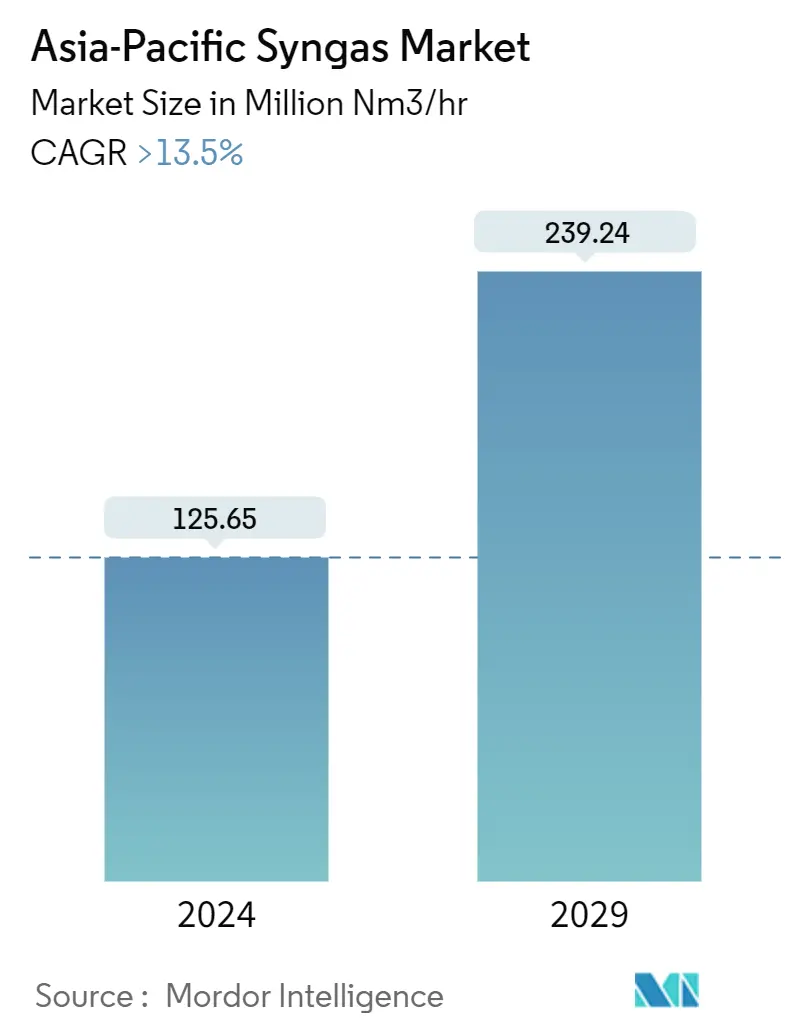
| Study Period | 2019-2029 |
| Base Year For Estimation | 2023 |
| Forecast Data Period | 2024 - 2029 |
| Historical Data Period | 2019 - 2022 |
| CAGR (2024 - 2029) | 13.50 % |
| Market Concentration | Low |
Major Players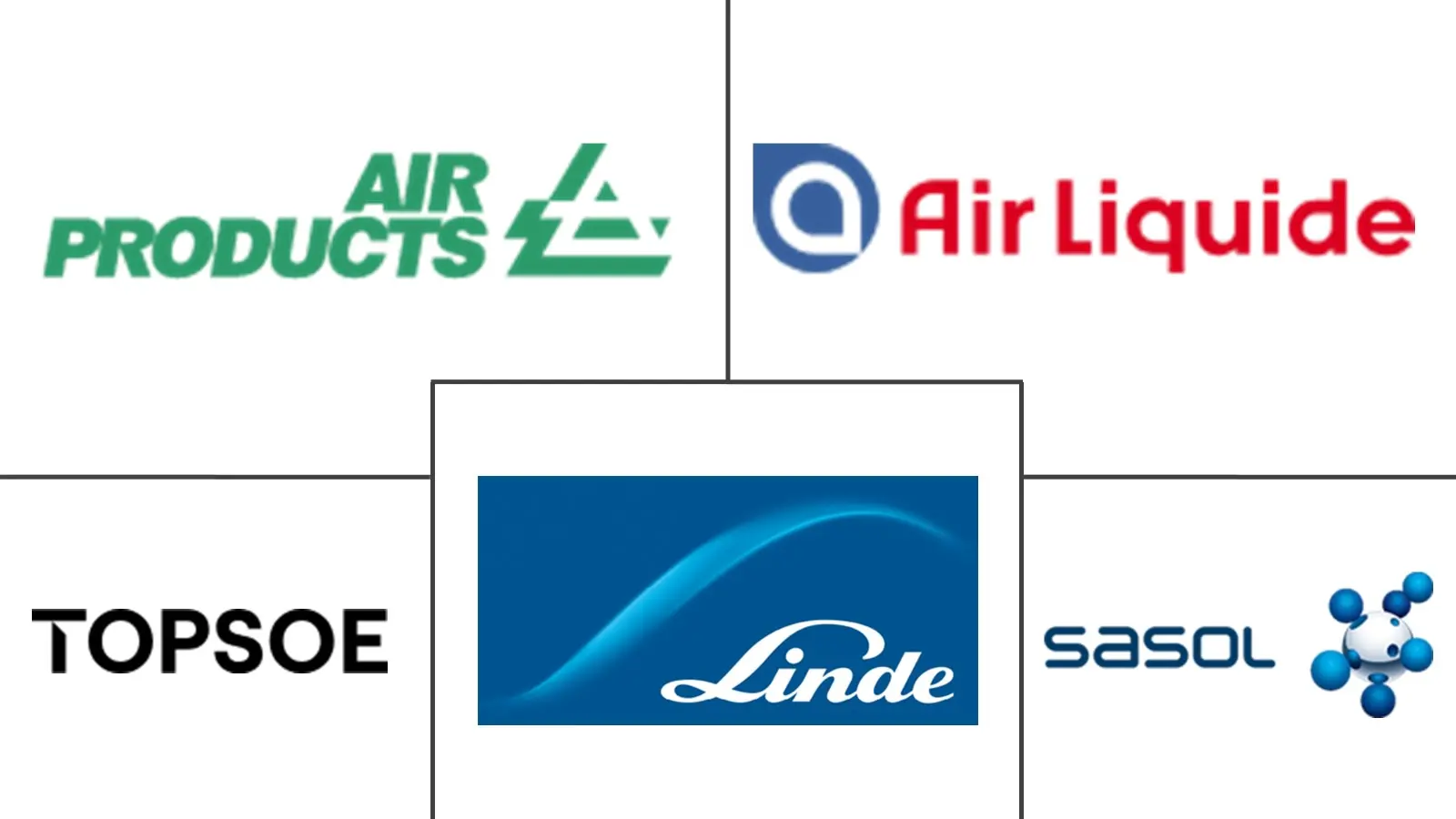
*Disclaimer: Major Players sorted in no particular order |
Asia Pacific Syngas Market Analysis
The Asia-Pacific Syngas Market size is estimated at 125.65 Million metric normal cubic meters per hour (mm nm³/h) in 2024, and is expected to reach 239.24 Million metric normal cubic meters per hour (mm nm³/h) by 2029, growing at a CAGR of greater than 13.5% during the forecast period (2024-2029).
- The Asia-Pacific Sngas market was negatively affected by the COVID-19 pandemic. China was worst hit by the COVID pandemic in the region. The pandemic resulted in the closure of chemical production plants in countries like India and China, thereby affecting the market for syngas. However, the market recovered well after the restrictions were lifted. The market recovered significantly, owing to the rise in consumption of syngas in power generation and chemical industries.
- The growing demand for syngas from the electricity and chemical industry, increasing environmental awareness and government regulations on renewable fuel use, and increasing hydrogen demand for fertilizers are expected to drive the growth of the market.
- The syngas production plant setup requires high capital investment and funding, which is expected to hinder market growth.
- The development of underground coal gasification technology is likely to act as an opportunity in the future.
- China is expected to dominate the market due to the rising demand for syngas in the power generation and chemical industries. It is also expected to register the highest CAGR during the forecast period.
Asia Pacific Syngas Market Trends
Ammonia Application Segment to Dominate the Market
- Syngas is a byproduct of the industrial synthesis of ammonia and fertilizer. Throughout this process, methane (from natural gas) reacts with water to produce carbon monoxide, and hydrogen (from natural gas) reacts with water to produce carbon monoxide and hydrogen. The gasification process is used to transform any carbon-containing substance into longer hydrocarbon chains.
- Through the Haber-Bosch process, syngas can be turned into ammonia, which is a standard part of fertilizers. During this process, nitrogen from the air is mixed with hydrogen from the syngas to make ammonia, which can then be used to make different kinds of fertilizers.
- Using syngas as a source of raw materials to make fertilizer has a number of advantages. For example, syngas can be made from a number of different materials, which gives companies more options and makes them less reliant on a single raw material. Also, making syngas from biomass by gasifying it can help cut down on greenhouse gas emissions compared to making fertilizer from fossil fuels.
- China accounts for approximately 7% of the overall agricultural acreage globally, thus feeding 22% of the world’s population. The country is the largest producer of various crops, including rice, cotton, potatoes, and others. Hence, the demand for ammonia, which is used as a fertilizer, is rapidly increasing owing to the large-scale agricultural activities in the country.
- China is the largest producer and consumer of ammonia in the world. According to the US Geological Survey (USGS), the country produced 42 million metric tons in 2022. The demand for ammonia in the country is rising due to increasing applications in the agriculture industry, such as fertilizers, textiles, pharmaceuticals, and mining.
- Similarly, in India, the demand for ammonia is increasing in the agriculture, textile, and chemical industries. Thus, various companies are increasing their ammonia production capacity in the country. For instance, in May 2023, Deepak Fertilisers and Petrochemicals Corporation (DFPC) announced that it would be commissioning a new USD 522.5 Million ammonia plant and start production by the start of the second half of this year. The company is adding a capacity of 5,00,000 million tonnes per annum (MTPA) at Taloja in Maharashtra, which would take the total ammonia capacity to 6,28,700 MTPA.
- Thus, the increasing demand for ammonia is expected to drive the demand for syngas in the region during the forecast period.
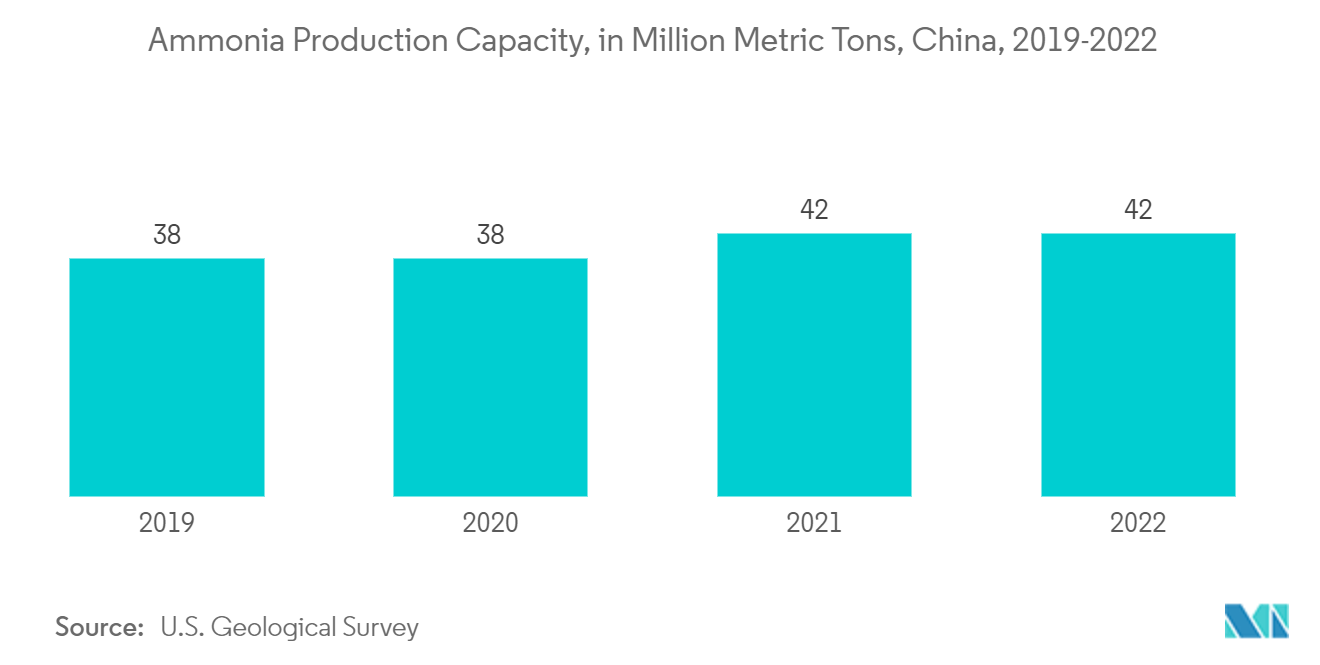
China to Dominate the Asia-Pacific Market
- In the Asia-Pacific region, China is the largest economy in terms of GDP. China is one of the fastest emerging economies and has become one of the biggest production houses in the world today. The country's manufacturing sector is one of the significant contributors to the country's economy.
- In China, the demand for syngas is increasing from power generation, chemicals and fertilizers, liquid fuels, and gaseous fuel applications. Thus, various companies are increasing the production capacity of syngas in the country, thereby driving the market.
- In China, Air Products was awarded a long-term onsite contract to supply syngas to Jiutai New Material Co. Ltd for its high-value mono-ethylene glycol project in Hohhot, China. The facility is designed to produce over 500,000 Nm3/hr of syngas, comprised of five gasifiers, two approximately 100,000 Nm3/hr air separation units (ASU) with syngas purification and processing, and associated infrastructure and utilities.
- China is a significant producer and exporter of fertilizers, particularly ammonia-based fertilizers. The country is home to several significant chemical businesses that specialize in fertilizer manufacture, and its ammonia-based fertilizers are in high demand both domestically and internationally.
- In the chemical industry, syngas is used to make chemicals and fuels. To make syngas, coal, petroleum coke, and biomass are turned into gas. In the chemical business, syngas is used to make methanol, ammonia, and hydrogen. Through the "gas-to-liquids" (GTL) process, carbon monoxide and hydrogen react to turn syngas into methanol. Methanol can be used to make formaldehyde, acetic acid, and other things.
- Syngas is both a fuel and a raw material. It can be used to heat boilers and heat exchangers in chemical plants and for other high-temperature industrial uses. According to the BASF chemical outlook report, the chemical production capacity in China will increase by 7.7% in 2022 as compared to the growth rate of 6.6% during the previous year. Thus the growth in the chemical industry is expected to drive the demand for syngas in the country.
- Increasing power generation in the country is boosting the demand for syngas. According to the China Electricity Council (CEC), in 2022, the power generation capacity in the country is registered at 2559.4 gigawatts, as compared to 2376.1 gigawatts of power generation capacity in the previous year. Thus, the increasing power generation capacity is expected to drive the demand for sungas in the country.
- Thus, the growth in chemical, fertilizer, and power generation industries is expected to drive the market for syngas in the country.
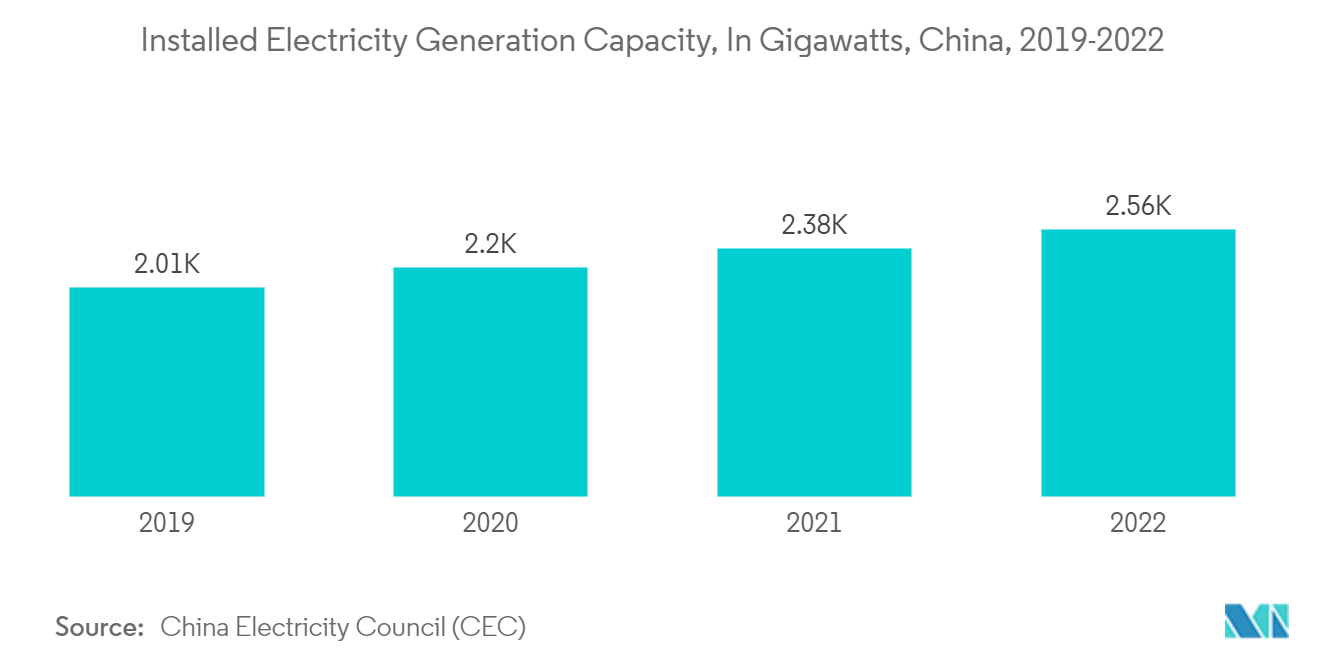
Asia Pacific Syngas Industry Overview
The Asia-Pacific Syngas Market is fragmented in nature. Some of the major players in the market include (not in any particular order) include Air Products and Chemicals, Inc., Air Liquide, Haldor Topsoe A/S, Linde plc, and Sasol, among others.
Asia Pacific Syngas Market Leaders
-
Air Products and Chemicals, Inc.
-
Linde plc
-
Air Liquide
-
Sasol
-
Haldor Topsoe A/S
*Disclaimer: Major Players sorted in no particular order
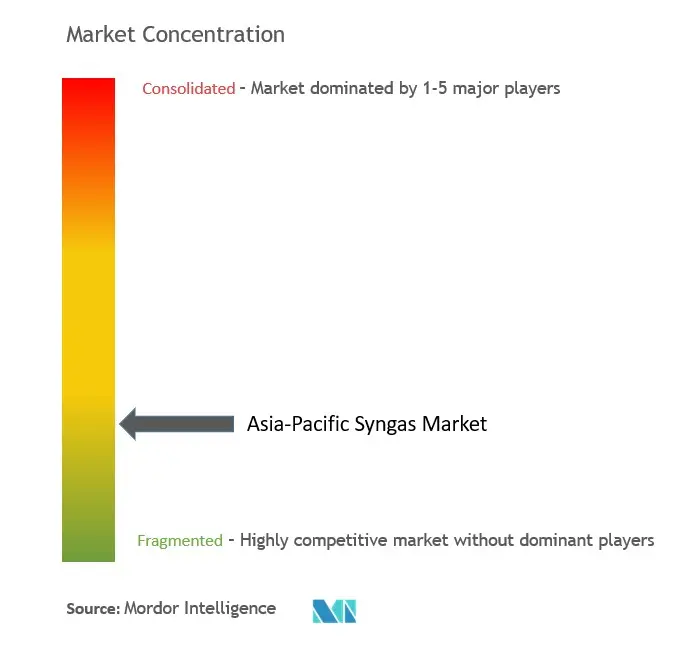
Asia Pacific Syngas Market News
- September 2023: BASF SE initiated the construction of its syngas plant at the Verbund site in Zhanjiang, China. Anticipated to become operational in 2025, this facility marks a strategic move by BASF SE to bolster its syngas production capacity in China.
- December 2022: Reliance Industries Ltd unveiled plans to manufacture blue hydrogen at a competitive cost ranging from USD 1.2 to 1.5 per kg. This initiative not only positions the company as a key player in the syngas market but also contributes to expanding the market for syngas in the country.
- December 2022: New Era Cleantech company committed a substantial investment of USD 2.5 Billion for the establishment of a cutting-edge coal gasification plant in Chandrapur, Maharashtra, India. This plant is designed to produce a versatile range of products, including syngas, hydrogen, methanol, and ammonia/urea.
Asia Pacific Syngas Market Report - Table of Contents
1. INTRODUCTION
- 1.1 Study Assumptions
- 1.2 Scope of the Study
2. RESEARCH METHODOLOGY
3. EXECUTIVE SUMMARY
4. MARKET DYNAMICS
-
4.1 Drivers
- 4.1.1 Feedstock Flexibility for Syngas Production
- 4.1.2 Growing Demand in the Electricity and Chemical Industries
- 4.1.3 Increasing Hydrogen Demand for Fertilizers
-
4.2 Restraints
- 4.2.1 High Capital Investment and Funding
- 4.2.2 Other Restraints
- 4.3 Industry Value Chain Analysis
-
4.4 Porter's Five Forces Analysis
- 4.4.1 Bargaining Power of Suppliers
- 4.4.2 Bargaining Power of Buyers
- 4.4.3 Threat of New Entrants
- 4.4.4 Threat of Substitute Products and Services
- 4.4.5 Degree of Competition
5. MARKET SEGMENTATION (Market Size in Volume)
-
5.1 Feedstock
- 5.1.1 Coal
- 5.1.2 Natural Gas
- 5.1.3 Petroleum
- 5.1.4 Pet Coke
- 5.1.5 Biomass
-
5.2 Technology
- 5.2.1 Steam Reforming
- 5.2.2 Partial Oxidation
- 5.2.3 Auto-thermal Reforming
- 5.2.4 Combined or Two-step Reforming
- 5.2.5 Biomass Gasification
-
5.3 Gasifier Type
- 5.3.1 Fixed Bed
- 5.3.2 Entrained Flow
- 5.3.3 Fluidized Bed
-
5.4 Application
- 5.4.1 Power Generation
- 5.4.2 Chemicals
- 5.4.2.1 Methanol
- 5.4.2.2 Ammonia
- 5.4.2.3 Oxo Chemicals
- 5.4.2.4 n-Butanol
- 5.4.2.5 Hydrogen
- 5.4.2.6 Dimethyl Ether
- 5.4.3 Liquid Fuels
- 5.4.4 Gaseous Fuels
-
5.5 Geography
- 5.5.1 China
- 5.5.2 India
- 5.5.3 Japan
- 5.5.4 South Korea
- 5.5.5 Australia & New Zealand
- 5.5.6 Rest of Asia-Pacific
6. COMPETITIVE LANDSCAPE
- 6.1 Mergers and Acquisitions, Joint Ventures, Collaborations, and Agreements
- 6.2 Market Share (%)**/Ranking Analysis
- 6.3 Strategies Adopted by Leading Players
-
6.4 Company Profiles
- 6.4.1 Air Products and Chemicals, Inc.
- 6.4.2 Air Liquide
- 6.4.3 BASF SE
- 6.4.4 BP p.l.c.
- 6.4.5 DuPont
- 6.4.6 General Electric
- 6.4.7 Haldor Topsoe A/S
- 6.4.8 KBR Inc
- 6.4.9 Linde plc
- 6.4.10 Royal Dutch Shell plc
- 6.4.11 Sasol
- 6.4.12 Siemens
- 6.4.13 SynGas Technology LLC
- 6.4.14 TechnipFMC plc
- *List Not Exhaustive
7. MARKET OPPORTUNITIES AND FUTURE TRENDS
- 7.1 Utilization of Biomass and Municipal Waste
- 7.2 Development of Underground Coal Gasification Technology
Asia Pacific Syngas Industry Segmentation
Syngas is a gaseous mix containing mainly hydrogen and carbon monoxide, mostly produced from steam reforming and gasification. It can be used to produce chemicals such as ammonia, acetic acid, butanol, methanol, and dimethyl ether. The fertilizer segment mainly consumes ammonia, and methanol and dimethyl ether can be used as fuel.
The syngas market is segmented by feedstock, technology, gasifier type, application, and geography. By feedstock, the market is segmented into coal, natural gas, petroleum, pet coke, and biomass. By technology, the market is segmented into steam reforming, partial oxidation, auto-thermal reforming, combined reforming, and biomass gasification. By gasifier type, the market is segmented into fixed bed, entrained flow, and fluidized bed. By application, the market is segmented into power generation, chemicals (methanol, ammonia, oxo chemicals, n-butanol, hydrogen, and dimethyl ether), liquid fuels, and gaseous fuels. The report also covers the market size and forecasts for the Asia-Pacific Syngas market for five major countries.
For each segment, the market sizing and forecasts are provided in terms of volume (million metric normal cubic meters per hour (MM NM³/h)).
| Feedstock | Coal | |
| Natural Gas | ||
| Petroleum | ||
| Pet Coke | ||
| Biomass | ||
| Technology | Steam Reforming | |
| Partial Oxidation | ||
| Auto-thermal Reforming | ||
| Combined or Two-step Reforming | ||
| Biomass Gasification | ||
| Gasifier Type | Fixed Bed | |
| Entrained Flow | ||
| Fluidized Bed | ||
| Application | Power Generation | |
| Chemicals | Methanol | |
| Ammonia | ||
| Oxo Chemicals | ||
| n-Butanol | ||
| Hydrogen | ||
| Dimethyl Ether | ||
| Liquid Fuels | ||
| Gaseous Fuels | ||
| Geography | China | |
| India | ||
| Japan | ||
| South Korea | ||
| Australia & New Zealand | ||
| Rest of Asia-Pacific |
Asia Pacific Syngas Market Research FAQs
How big is the Asia-Pacific Syngas Market?
The Asia-Pacific Syngas Market size is expected to reach 125.65 million metric normal cubic meters per hour (mm nm³/h) in 2024 and grow at a CAGR of greater than 13.5% to reach 239.24 million metric normal cubic meters per hour (mm nm³/h) by 2029.
What is the current Asia-Pacific Syngas Market size?
In 2024, the Asia-Pacific Syngas Market size is expected to reach 125.65 million metric normal cubic meters per hour (mm nm³/h).
Who are the key players in Asia-Pacific Syngas Market?
Air Products and Chemicals, Inc., Linde plc, Air Liquide, Sasol and Haldor Topsoe A/S are the major companies operating in the Asia-Pacific Syngas Market.
What years does this Asia-Pacific Syngas Market cover, and what was the market size in 2023?
In 2023, the Asia-Pacific Syngas Market size was estimated at 108.69 million metric normal cubic meters per hour (mm nm³/h). The report covers the Asia-Pacific Syngas Market historical market size for years: 2019, 2020, 2021, 2022 and 2023. The report also forecasts the Asia-Pacific Syngas Market size for years: 2024, 2025, 2026, 2027, 2028 and 2029.
Asia Pacific Syngas Industry Report
Statistics for the 2024 Asia Pacific Syngas market share, size and revenue growth rate, created by Mordor Intelligence™ Industry Reports. Asia Pacific Syngas analysis includes a market forecast outlook 2029 and historical overview. Get a sample of this industry analysis as a free report PDF download.



